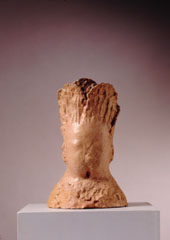"Collection 1: Figurative Art since 1970 / 1970年以降の具象的表現"
The National Museum of Art, Osaka, Osaka, Japan / 国立国際美術館(大阪)
29. 04. 2005 - 18. 07. 2005

Cabagged Head, 1994, Glazed terracotta, 34.5 x 21.7 x 19 cm, The National Museum of Art, Osaka, Osaka, Japan © Leiko Ikemura and VG Bild-Kunst Bonn, 2021. / Photo: Lothar Schnepf.
As it turned toward abstraction at the beginning of the 20th century, Western art's link to the ordinary, visible world grew increasingly weak, and becoming overly fragmented and analytical, a tendency to emphasize the conceptual took hold. By the 1970s, this process had played itself out. But in the interim, European figurative sculpture in particular had dwindled.
It was at this point, in the 1970s, that Stephan Balkenhol was a university student. In right of the simple, dense art that was receiving recognition at the time, Balkenhol decided he would like to create art that was more appropriate to the era in which he was living. Thus, he began to explore the possibilities of figurative sculpture, which at the time was completely ignored. What emerged were wooden sculptures of people and animals, and reliefs depicting landscapes. These works can be seen as the culmination of Balkenhol's reexamination of thousands of years of European sculpture from ancient Egypt to the beginning of the 20th century, and as wooden sculptures and reliefs that adopt the lessons of minimal art, are without precedent.
Figurative works from the 1970s to the present are being presented as "Collection 1." Although the works are figurative, they are not merely intended to complete with reality. In the atmosphere of peace and prosperity, the rise of democratization and the development of scientific technology that came about following postwar reconstruction, each artist, while breathing in the air of the era, has attempted to create work that deals with important issues and personal interests.
The content that each artist attempts to express is as rich in diversity at contemporary society, which defies easy explanation; it varies according to a host of factors such the individual's values, environment and generation as well as the year that a work was produces. The variety is just as evident when viewed from a technical perspective - not only are there examples of traditional media like bronze sculpture, oil painting and copper engraving, but there are also works that make use of techniques that previously unknown in art. Photographic technology, with its ability to accurately replicate reality, has a variety of uses, making it an important symbol of figurative expression in our time. And over the past ten years or so, the wide range of figurative works as a whole seem to have shed some light on this period we call the contemporary.
-----
20世紀初頭に抽象化が始まって以降の欧米の美術は、全体として、ふだん目にする世界との関係は弱まり、断片的かつ分析的になり、またコンセプトを重視する傾向がどんどん強くなってゆき、1970年代にその限界に到達しました。特にヨーロッパの具象彫刻は、抽象的で観念的な傾向が強まる時代風潮の中で、先細りするばかりでした。
シュテファン・バルケンホールは、まさにそのような1970年代に学生時代を過ごしました。彼は、当時のシンプルで隙のない芸術を高く評価したものの、自分の生きる時代に一層ふさわしい芸術を創造したいと考え、当時見向きもされなかった具象彫刻の可能性を模索しました。結果、誕生したのが、木による人物や動物の彫刻やレリーフであり、風景のレリーフです。それらは、古代エジプトから20世紀初頭までの数千年におよぶヨーロッパの彫刻を学びなおした結果であり、特にミニマルアートの成果を取りこんだ類例のない木の彫刻とレリーフといえるでしょう。
『コレクション1』においては、1970年頃から現在までの具象的作品を展示しています。人物や動物や風景を題材にしたそれらの作品は、見かけ上は具象的であっても、単に写実性を競ったものではありません。それらは、戦後復興後の反映と平和、また大衆化現象、さらには科学技術の発展のもとで、芸術家めいめいが、時代の空気を吸いながら、美術における問題意識や自己の関心事を造形化した作品です。
各芸術家が表現しようとしている内容は、現代社会が一言では説明しきれないのと同じく変化に富み、各人の価値観や生活環境や世代などの相違、また制作年の相違などに応じて異なっています。技術面から見ても同様で、伝統的なブロンズ彫刻や油彩画や銅版画だけではなく、従来美術に用いられることのなかった意外な技術による作品も含まれています。現実を正確に写し取ることができる写真技術が、さまざまな用いられ方をしていますが、それはこの時代の具象的表現の重要な特徴でもあります。これら過去数十年の多種多様な具象的作品は、全体として、現代という時代を照らし出しているのではないでしょうか。
Figurative Art SINCE 1970 / 1970年以降の具象的表現
Georg BASELITZ / ゲオルク・バゼリッツ, Cecco BONANOTTE / チェッコ・ボナノッテ, Katsura FUNAKOSHI / 船越桂, Rieko HIDAKA / 日高理恵子, Leiko IKEMURA / イケムラレイコ, Zon ITO / 伊藤存, Ilya KABAKOV / イリヤ・カバコフ, Tetsuro KOMAI / 駒井哲郎, Yasumasa MORIMURA / 森村泰昌, Vik MUNIZ / ヴィック・ムニーズ, Tony OURSLER / トニー・アウスラー, Pablo PICASSO / パブロ・ピカソ, Jean-Pierre RAYNAUD / ジャン=ピエール・レイノー, Thomas RUFF / トーマス・ルフ, Niki de SAINT-PHALLE / ニキ・ド・サンファール, Karin SANDER / カリン・ザンダー, Churyo SATO / 佐藤忠良, Kiki SMITH / キキ・スミス, Yoshitatsu YANAGIHARA / 柳原義達, Andy WARHOL / アンディ・ウォーホル
B1F
Alexander CALDER / アレキサンダー・コールダー, Joan MIRÓ / ジョアン・ミロ, Henry MOORE / ヘンリー・ムア, Jiro TAKAMATSU / 高松次郎
The National Museum of Art, Osaka
4-2-55 Nakanoshima, Kita-ku
Osaka, 530-0005
Tel. +81-6-6447-4680
www.nmao.go.jp/en/
---
国立国際美術館
530-0005
大阪府大阪市北区中之島4-2-55
Tel. 06-6447-4680(代)
www.nmao.go.jp
Sources: Floor plan 1, Floor plan 2, The National Museum of Art, Osaka, 国立国際美術館